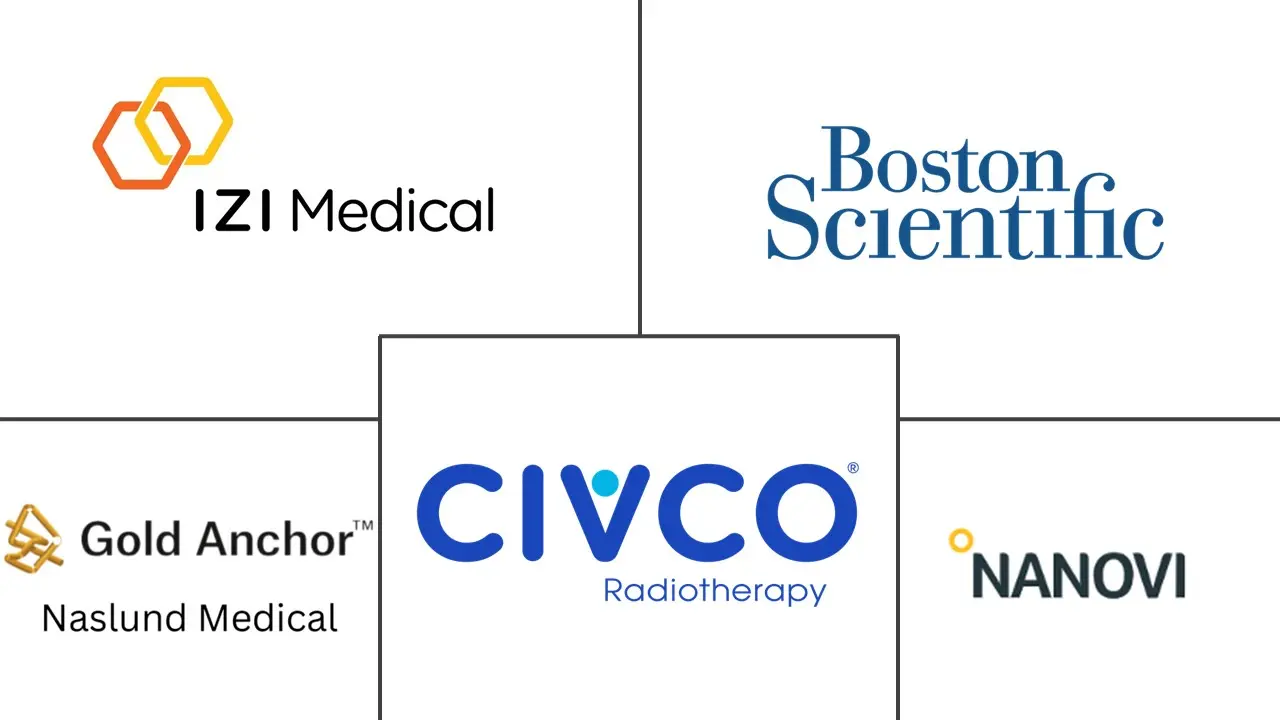Fiducial Markers Market Size and Share
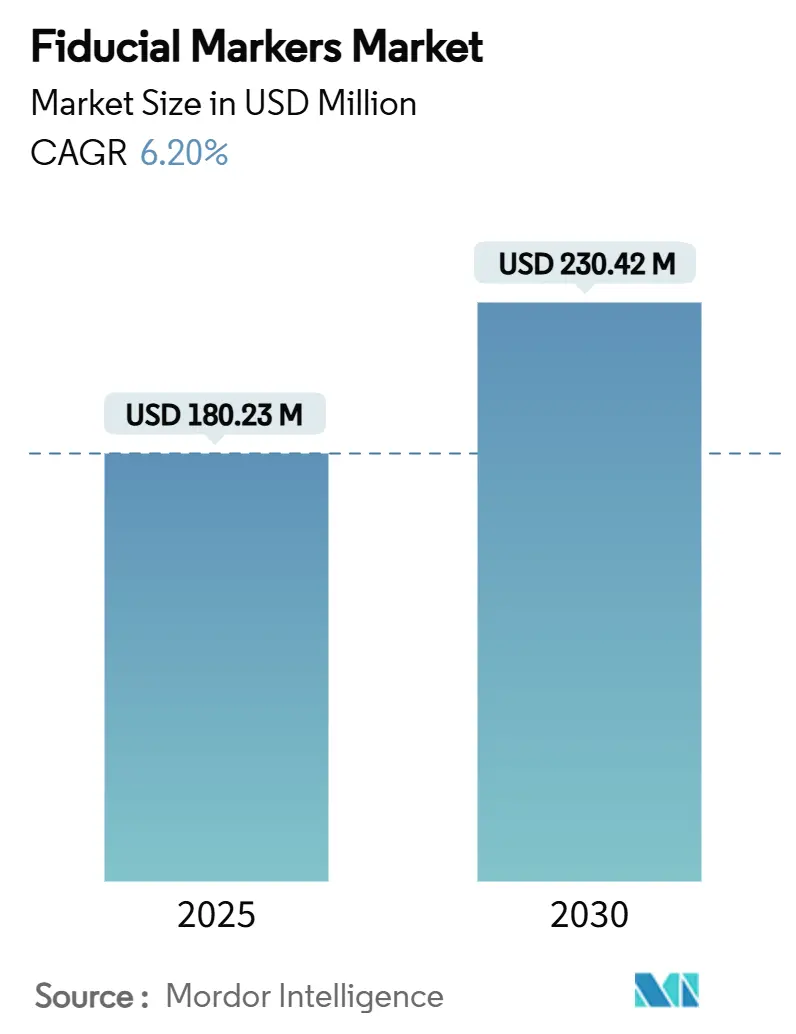
Fiducial Markers Market Analysis by Mordor Intelligence
The fiducial markers market stands at USD 180.23 million in 2025 and is forecast to reach USD 230.42 million by 2030, advancing at a 6.2% CAGR through the period. Growth is anchored in the need for sub-millimeter localization accuracy as image-guided radiotherapy (IGRT) becomes the standard of care across oncology centers. A steady rise in global cancer diagnoses, with over 20 million new cases reported in 2023, continues to expand the patient pool requiring radiation treatment. At the same time, hospital investments in CT/CBCT, MRI-linac, and proton therapy equipment upgrade workflows that depend on implanted or injectable reference points. Payer policies in North America and parts of Europe now reimburse fiducial placement when clinically justified, encouraging providers to adopt value-adding marker innovations. Competitive intensity remains moderate, but recent strategic acquisitions, such as Lantheus Holdings’ January 2025 purchase of Evergreen Theragnostics and Life Molecular Imaging, illustrate a shift toward bundled imaging therapeutic solutions that enhance differentiation.
Key Report Takeaways
- By product, gold-based fiducials held 49.9% of 2024 revenue; liquid hydrogel markers are projected to grow at a 9.5% CAGR to 2030.
- By modality, CT/CBCT systems commanded 57.6% of the fiducial markers market share in 2024, while MRI-guided systems exhibit the fastest expansion at 8.2% through 2030.
- By application, prostate cancer accounted for 38.2% of 2024 demand; pancreatic and liver use cases are advancing at a 9.4% CAGR.
- By end user, hospitals represented 63.4% of 2024 sales, yet ambulatory radiotherapy clinics are growing at 7.8% as outpatient care scales.
- geographically, North America led with 38.4% revenue share in 2024, while Asia-Pacific is projected to grow at a 6.9% CAGR through 2030.
Global Fiducial Markers Market Trends and Insights
Drivers Impact Analysis
| Driver | (~) % Impact on CAGR Forecast | Geographic Relevance | Impact Timeline |
|---|---|---|---|
| Growing Incidence Of Cancer | 1.80% | Global | Long term (≥ 4 years) |
| Rising Adoption Of Image-Guided Radiotherapy | 1.50% | North America & EU, APAC core | Medium term (2-4 years) |
| Increasing Reimbursement Coverage For IGRT Procedures | 1.20% | North America & EU | Medium term (2-4 years) |
| Emergence Of Liquid Hydrogel Fiducials For MRI-Guided Adaptive RT | 0.90% | Global, with early gains in North America, Germany | Short term (≤ 2 years) |
| AI-Driven Real-Time Tumor-Tracking Systems Boosting Fiducial Demand | 0.60% | North America, EU, Japan | Short term (≤ 2 years) |
| Expansion Of Proton Therapy Centers Globally | 0.40% | Global, concentrated in developed markets | Long term (≥ 4 years) |
| Source: Mordor Intelligence | |||
Growing Incidence of Cancer
Global cancer diagnoses climbed to more than 20 million in 2023, and epidemiologists project roughly 35 million annual cases by 2050, expanding radiotherapy utilization and, consequently, fiducial marker demand.[1]International Agency for Research on Cancer, “GLOBOCAN 2022,” iarc.who.int Half of all cancer patients eventually receive radiation, and tumors such as prostate and lung malignancies, which together dominate fiducial placement, are highly correlated with aging demographics in high-income nations. Asia-Pacific now absorbs a rising portion of this burden, and the region’s capital spending on linear accelerators and particle therapy rooms is accelerating to keep pace. Hospitals in urban China and India increasingly mandate IGRT workflows, positioning the fiducial markers market for sustained long-term growth.
Rising Adoption of Image-Guided Radiotherapy
Cone-beam CT has become a routine adjunct on modern linacs, explaining CT/CBCT’s 57.6% 2024 share of the fiducial markers market. Newer MRI-linac installations deliver superior soft-tissue contrast but require fiducials that do not distort magnetic images; liquid hydrogels, therefore, gain ground at an 8.2% CAGR. The February 2024 FDA clearance for Varian’s HyperSight upgraded CBCT workflow and halved image acquisition time, improving throughput and marker visualization. Even “markerless” tracking research cements the importance of high-contrast reference objects because algorithm training relies on fiducial benchmarks that underpin accuracy ratings.
Increasing Reimbursement Coverage for IGRT Procedures
Since 2024, the US Centers for Medicare & Medicaid Services has clarified billing rules for IGRT, allowing separate payment for fiducial placement when medically necessary.[2]Centers for Medicare & Medicaid Services, “Transmittal 12052: IGRT Billing Guidance,” cms.govSeveral EU payers have followed, assigning bundled Diagnosis-Related Group add-ons once practitioners document outcome advantages. The resulting revenue certainty is persuading outpatient oncology chains to install marker-friendly imaging suites, a dynamic that helps ambulatory clinics outpace hospital growth rates. Payers also view fewer treatment fractions and lower toxicity as downstream savings, reinforcing a pro-fiducial coverage stance.
Emergence of Liquid Hydrogel Fiducials for MRI-Guided Adaptive RT
Hydrogel formulations such as BioXmark improve multimodal visibility and create negligible CT artifacts while offering conspicuous MRI contrast, attributes that reduce replanning events and shorten simulation sessions. The clinical series on EUS-guided pancreatic placement reports technical success of 85–100%, with adverse events under 7.6%, giving physicians confidence in treating anatomically challenging sites.[3PubMed, “Fiducial Migration Meta-analysis,” pubmed.ncbi.nlm.nih.gov ] As proton-MRI prototypes move from research to clinical pilots, for instance, Dresden launched the first in January 2024, demand for artifact-free, absorbable markers is set to surge.
Restraints Impact Analysis
| Restraint | (~) % Impact on CAGR Forecast | Geographic Relevance | Impact Timeline |
|---|---|---|---|
| High Unit Cost Of Gold-Based Markers | -0.80% | Global, particularly cost-sensitive markets | Medium term (2-4 years) |
| Risk Of Marker Migration Causing Re-Planning | -0.60% | Global | Short term (≤ 2 years) |
| MRI Artefacts Interfering With Auto-Segmentation Workflows | -0.40% | Global, concentrated in MRI-guided RT centers | Short term (≤ 2 years) |
| Stringent Regulatory Approval Timelines For Novel Fiducials | -0.30% | North America, EU | Long term (≥ 4 years) |
| Source: Mordor Intelligence | |||
High Unit Cost of Gold-Based Markers
A single gold marker can cost multiples of polymer alternatives, and patients often need three per lesion, straining budgets in capitated systems. While clinical familiarity upholds gold’s 49.9% share, buyers in Brazil, India, and parts of Eastern Europe now trial polymer or hydrogel substitutes that offer lower acquisition and placement costs without compromising visibility. Hospitals using activity-based costing find that total episodic spend falls when market price declines, particularly once imaging verification and replanning overheads are included.
Risk of Marker Migration Causing Re-Planning
Migration rates of 1.7–7.6% interrupt treatment schedules, trigger added CT scans, and divert physicist time toward recontouring. In prostate and liver cases, even a 2 mm shift forces dose redistribution to protect surrounding structures, delaying therapy initiation. Manufacturers now add helical grooves and deployable wings to improve tissue anchorage, yet smaller ambulatory centers may lack the resources to buy newer designs.
Segment Analysis
By Product: Diversifying Beyond Gold
Gold-based devices comprised 49.9% of the fiducial markers market share in 2024, reflecting decades of decision-maker confidence in their radiopacity and inertness. Yet polymer, platinum, and hydrogel formats are steadily chipping away at that dominance as MRI-compatible workflows expand. The fiducial markers market size attributed to liquid hydrogels is rising at a 9.5% CAGR, aided by their artifact-free profile and eventual bio-absorption, a preference shared by clinicians and patients who seek temporary implants.
Clinical trials now demonstrate that polymer markers paired with CBCT achieve equivalent localization accuracy in prostate and lung stereotactic body radiotherapy. Cost differentials, sometimes exceeding 30% per lesion, are relevant in lower-middle-income countries where public insurance must stretch procurement budgets. Premium gold configurations, such as coiled designs that resist migration, retain utility in highly mobile organs, though their unit price limits uptake outside tertiary referral centers.
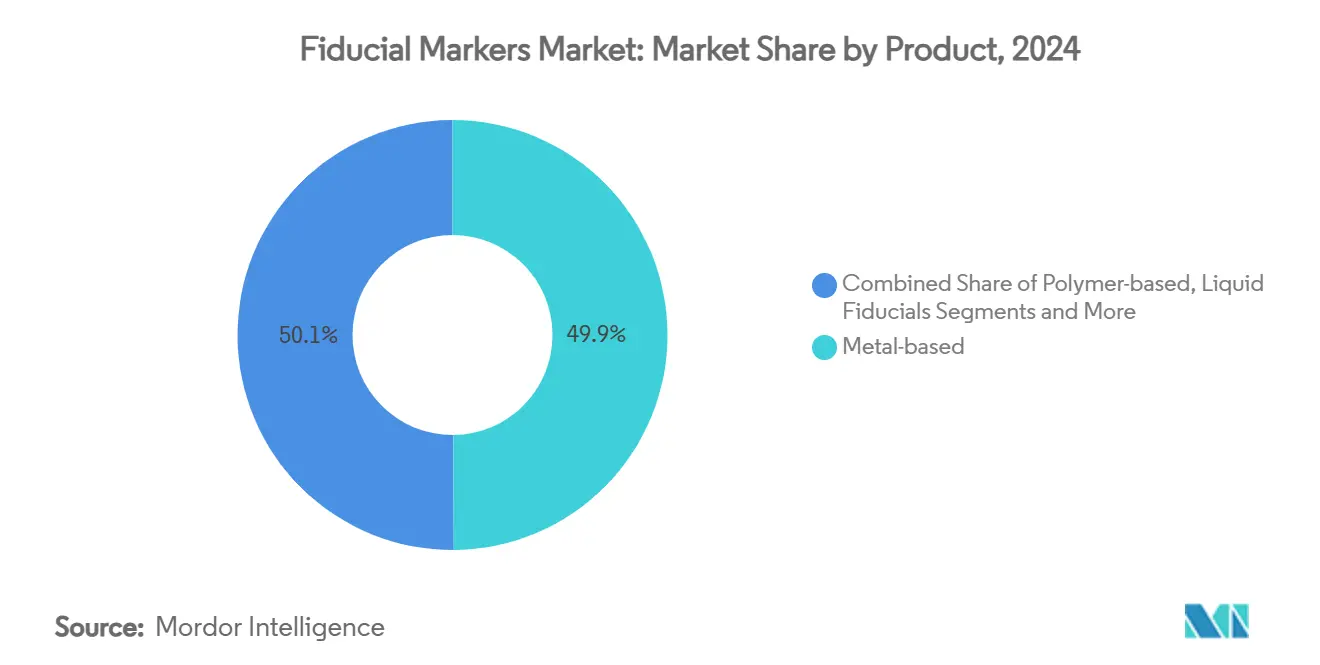
Note: Segment shares of all individual segments available upon report purchase
By Modality: CT/CBCT Remains the Workhorse
CT/CBCT systems generated 57.6% of fiducial markers market revenue in 2024 because nearly every linac fleet includes cone-beam hardware, ensuring consistent marker visibility. The fiducial markers market size linked to MRI-guided systems is, however, expanding at an 8.2% CAGR, signaling that soft-tissue contrast superiority is gaining fiscal endorsement among capital-rich centers.
Upgrades such as HyperSight elevate CBCT quality enough to reduce artifacts from metallic markers, prolonging CT relevance. Simultaneously, hybrid MRI-proton prototypes in Europe demonstrate early-stage promise but will need fiducial materials that do not upset magnetic homogeneity or proton range. Ultrasound continues as a placement modality in hepatobiliary lesions, although its real-time tracking role is dwarfed by X-ray or MRI.
By Application: Urology Leads, Gastrointestinal Oncology Accelerates
Prostate protocols dominated usage with 38.2% of 2024 because the gland’s motion relative to the bladder and rectum necessitates implanted references; gold coils remain the most commonly used design. Fiducial markers market size devoted to pancreatic and liver tumors is expanding, as EUS-guided injections mitigate the anatomical inaccessibility that previously limited high-dose SBRT in these organs.
Pancreatic fiducial placement can now be completed in less than 20 minutes under moderate sedation, contributing to the observed 9.4% CAGR in that sub-segment. Meanwhile, bronchoscopic marker deposition coupled with respiratory gating improves lung SBRT conformity. Breast surgery teams are adopting bio-absorbable clips visible on ultrasound and MRI for lumpectomy cavity localization, preferring temporary devices that do not alter mammographic follow-up.

Note: Segment shares of all individual segments available upon report purchase
By End User: Inpatient Strength, Outpatient Momentum
Hospital centers captured 63.4% of 2024 purchases due to integrated oncology departments that place markers during diagnostic imaging or surgery under one roof. Large teaching hospitals often bundle fiducial spend into broader capital budgets that include linac and imaging upgrades.
Conversely, ambulatory clinics, growing at 7.8%, capitalize on payer incentives that favor shorter care cycles and convenient access. These facilities frequently outsource marker placement to interventional radiologists, yet have begun training in-house teams to cut referral delays, boosting throughput. Cancer specialty centers leverage advanced modalities and AI-enhanced tracking to command premium reimbursements, making them early adopters of polymer and hydrogel innovations.
Geography Analysis
North America led the fiducial markers market in 2024, backed by high per-capita health expenditure and clear reimbursement for IGRT procedures. Regulatory certainty under the FDA’s 510(k) process encourages continuous product iteration, while academic centers such as Penn Medicine drive early clinical validation for emerging designs.
Europe follows, supported by structured healthcare financing and the EU MDR framework, which, though demanding, facilitates continent-wide market entry once clearance is earned. Dresden’s MRI-guided proton program showcases European leadership in adaptive technologies reliant on non-metallic fiducials. National authorities, particularly in Germany and the Nordics, reward cost-effective innovations, spurring polymer uptake.
Asia-Pacific is the fastest-growing region, buoyed by national cancer plans in China, Japan, and South Korea that fund proton rooms and high-end MRI-linacs. China’s 77 active proton or heavy-ion projects highlight scale, while local firms develop cost-optimized polymer markers tailored to domestic price points. In Southeast Asia, private hospital chains import hydrogel devices for liver and pancreatic programs catering to medical tourism.
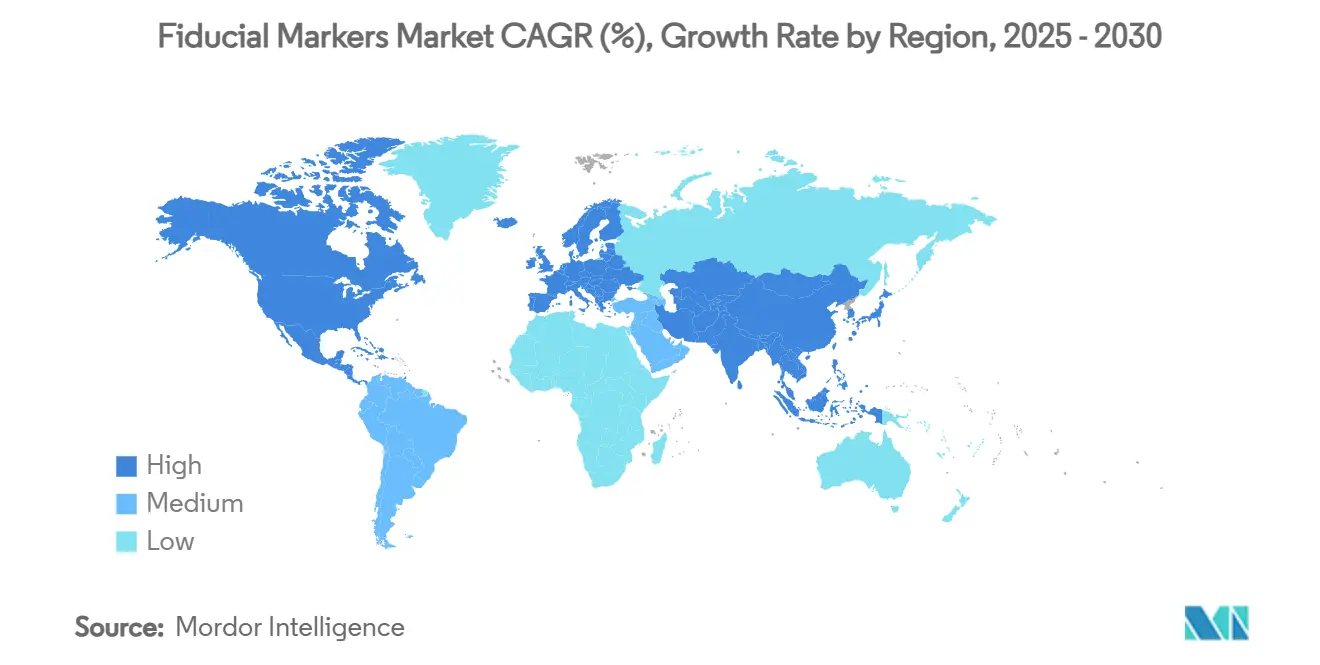
Competitive Landscape
Competition is moderate, featuring specialized firms and diversified med-tech conglomerates. IZI Medical Products, CIVCO Radiotherapy, and Gold Anchor hold strong brand equity on the strength of long-term clinical data, while enterprises such as Medtronic and Boston Scientific enter through adjacent interventional portfolios. Strategic alliances trend upward: Lantheus Holdings’ early-2025 dual acquisition strengthens its diagnostic-theranostic bundling capability, foreshadowing integrated care models.
Technological differentiation surrounds material science and AI. Hydrogel developers emphasize MRI clarity and absorption profiles, whereas polymer innovators stress cost control. Siemens-Varian’s HyperSight release demonstrates hardware–marker co-development as a route to lock-in, integrating imaging protocols pre-tuned for specific fiducials. Patent filings covering coiled shapes and AI detection algorithms remain brisk at the USPTO, signaling ongoing innovation cycles.
Financial resilience is an emerging separator. ViewRay’s April 2025 Chapter 11 filing shows that even clinically lauded systems can falter without scale. In contrast, integrators with broad oncology software stacks enjoy recurring revenue that cushions R&D risk. M&A activity is therefore expected to tighten market concentration moderately over the forecast horizon.
Fiducial Markers Industry Leaders
-
IZI Medical Products
-
CIVCO Radiotherapy
-
Boston Scientific Corp.
-
Gold Anchor (Naslund Med.)
-
Nanovi A/S
- *Disclaimer: Major Players sorted in no particular order
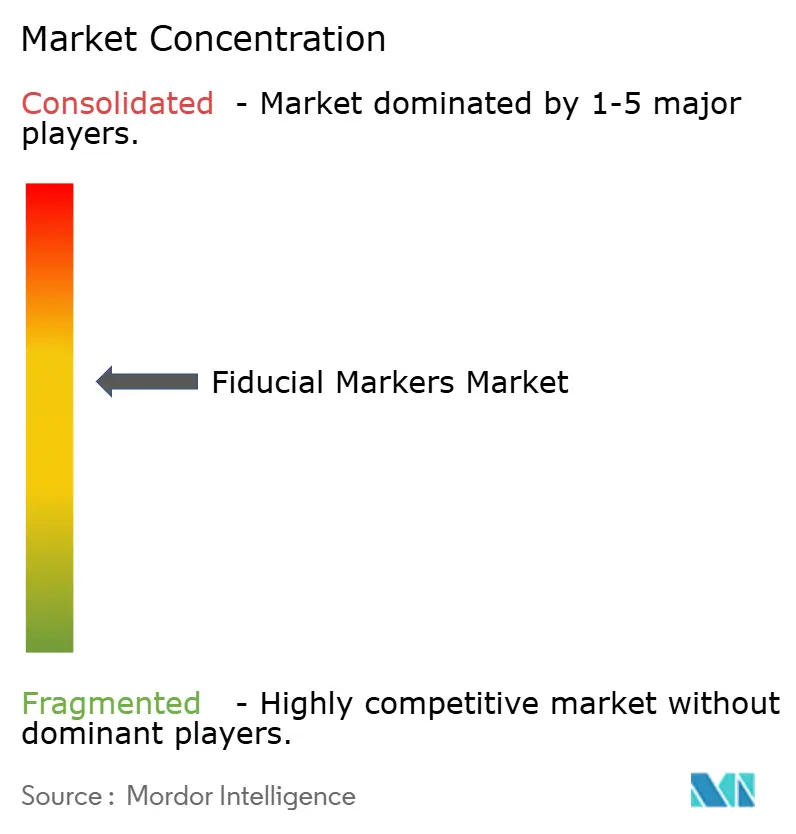


Recent Industry Developments
- May 2025: IBA introduced the myQA Blue Phantom³ water phantom, which automates gantry leveling in under 30 seconds and adds contact-free alignment that streamlines beam QA.
- April 2025: Penn Medicine allocated USD 224 million for a two-room ProteusONE proton center scheduled for 2027.
- February 2025: Varian secured FDA clearance for HyperSight imaging on TrueBeam and Edge, cutting CBCT scan time by 50%.
- January 2025: Lantheus closed the acquisitions of Evergreen Theragnostics and Life Molecular Imaging, reinforcing its oncology radiopharmaceutical pipeline.
Global Fiducial Markers Market Report Scope
As per the scope, Fiducial markers also referred to as fiducial are object which is placed in or near to tumor in the process of radiotherapy. This marker helps in pinpoint the tumor location with high accuracy and allows maximum radiation dosage to deliver resulting in accurate radiation dosage.
| Metal-based |
| Polymer-based |
| Liquid / Hydrogel Fiducials |
| Bio-absorbable Markers |
| CT / CBCT |
| MRI |
| Ultrasound |
| X-Ray / Fluoroscopy |
| Hybrid MRI-LINAC systems |
| Prostate Cancer |
| Lung Cancer |
| Breast Cancer |
| Liver and Pancreatic Cancers |
| Others |
| Hospitals |
| Cancer Specialty Centers |
| Ambulatory Radiotherapy Clinics |
| Others |
| North America | United States |
| Canada | |
| Mexico | |
| Europe | Germany |
| United Kingdom | |
| France | |
| Italy | |
| Spain | |
| Rest of Europe | |
| Asia Pacific | China |
| Japan | |
| India | |
| South Korea | |
| Australia | |
| Rest of Asia Pacific | |
| Middle East & Africa | GCC |
| South Africa | |
| Rest of Middle East & Africa | |
| South America | Brazil |
| Argentina | |
| Rest of South America |
| By Product | Metal-based | |
| Polymer-based | ||
| Liquid / Hydrogel Fiducials | ||
| Bio-absorbable Markers | ||
| By Modality | CT / CBCT | |
| MRI | ||
| Ultrasound | ||
| X-Ray / Fluoroscopy | ||
| Hybrid MRI-LINAC systems | ||
| By Application | Prostate Cancer | |
| Lung Cancer | ||
| Breast Cancer | ||
| Liver and Pancreatic Cancers | ||
| Others | ||
| By End-User | Hospitals | |
| Cancer Specialty Centers | ||
| Ambulatory Radiotherapy Clinics | ||
| Others | ||
| Geography | North America | United States |
| Canada | ||
| Mexico | ||
| Europe | Germany | |
| United Kingdom | ||
| France | ||
| Italy | ||
| Spain | ||
| Rest of Europe | ||
| Asia Pacific | China | |
| Japan | ||
| India | ||
| South Korea | ||
| Australia | ||
| Rest of Asia Pacific | ||
| Middle East & Africa | GCC | |
| South Africa | ||
| Rest of Middle East & Africa | ||
| South America | Brazil | |
| Argentina | ||
| Rest of South America | ||


Key Questions Answered in the Report
What is the current value of the fiducial markers market?
The market is valued at USD 180.23 million in 2025 and is projected to hit USD 230.42 million by 2030.
Which product type leads the fiducial markers market in 2025?
Gold-based markers remain dominant, holding 49.9% of 2024 revenue because of proven radiopacity and physician familiarity.
How quickly is the MRI-guided segment growing?
MRI-compatible fiducial solutions are expanding at an 8.2% CAGR through 2030, the fastest among imaging modalities.
Why are liquid hydrogel fiducials gaining attention?
They exhibit high MRI visibility, create minimal CT artifacts, and absorb over time, driving a 9.5% CAGR in their segment.
Page last updated on:
